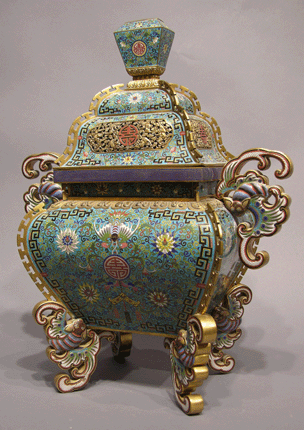
Second Half of 18th Century, Qing Dynasty
19½” h. 14¾” w. 9½” d
This antique ceremonial incense burner is of the “ding” type of ceremonial vessels, the forerunner of the ritual bronzes of Zhou Dynasty. It does not have an impressed reign mark as noted in the publication: “Chinese Cloisonne: The Pierre Uldry Collection”, large sumptuously decorated religious vessels were mostly commissioned to serve as a ceremonial furnishing in temples or chapels, and not for celebrating a monarch’s reign.
This vessel is attributed to the second half of the 18th century because of its style, motifs, enamel colors used, and technical workmanship. Of distinction is the application of Ormolu (alloy resembling gold), a French rococo style that came into cloisonne decoration on vessels during the reign of Emperor Qianlong. This monarch loved art and innovation. He invited Europeans to come to his court to help advance in technology and designs in metalwork. The Chinese artisans were encouraged to try out innovations while keeping to the traditional.
Like quality cloisonné of this period, this vessel has a solid heavy bronze body; the wires delineating the contours of the designs are fine, accurately bent and gilded. It has a turquoise-blue color ground in matte finish. The undulating bell shape lid is topped by a quadrangle knop with a trapezoid top. This knop is decorated with floral scrolls, with a “shou” character in the middle and a gilded floral frieze at the hem line. A recessed round gilded base connects the knop to the lid of the vessel.
The lid is decorated with a lotus motif among twining flowers. Embedded in its middle is a gilt lobed “taohuan” panel pierced with a host of gilded bats surrounding a red enameled “shou” character. These motifs evoke hope for a long life, happiness, and good fortune. Along the border of the vessel is a linked angular pattern in black and gold, meaning “everlasting”. The lid ends with a cobalt blue frieze with a meander-cloud design, symbol of wish for abundance from heaven. A row of gilded notched flanges march down the four corners of the burner. These flanges gleam gold in sunlight, the phenomenon is the essence of Ormolu.
The mouth of the vessel is decorated with a band of floral motifs. The body swells out then taper down to the base supported by four colorfully gilded bats as legs. A pair of bats are soldered to the top of the burner as handles. Scrolling floral vines cover the surface of the body and is adorned by four many-petaled lotus flowers. This complex flower form, with an ogee shape petal at the top, is typical of the design of the Qing period. Another telltale sign of the period is a colloidal pink showing on some flowers. This pink was not introduced into China until the first quarter of the 18th century. Appearing at the top part of the body of the vase is a design of a bat holding in its mouth a beaded string carrying a “shou” medallion from which dangles two patches with three tassels. This tassel design invokes the crowning decoration on some high official’s hat, making it credible this ceremonial vessel was commissioned by a person of high status to be placed in the chapel of his estate.